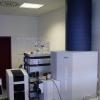Affinity capillary electrophoresis
In this project the special attention will be paid on the affinity capillary electrophoresis (ACE). This CE modification is a versatile analytical technique that has been shown to be an efficient and accurate tool to probe non-covalent interactions and to determine binding and dissociation constants between receptors and ligands. It utilizes the resolving power of CE to distinguish between free and bound forms of a receptor as a function of the concentration of free ligand. ACE benefits from a number of advantages over complimentary analytical techniques such as for examples classic gel electrophoresis or affinity liquid chromatography: i) only minute quantities of material are required; ii) sample need not be pure provided CE can distinguish the analyte of interest from the impurities; iii) radiolabeling of molecules is not necessary; iv) automated CE instrumentation is available, and; v) molecular interactions can be characterized in free solution. What is more ACE can be relatively simply transferred on a “lab on-a-chip” format.
Since 1992 when G. H. Whitesides introduced this term [1], ACE has been used for many purposes: protein-drug, protein-DNA, peptide-carbohydrate, peptide-peptide, DNA-dye, carbohydrate-drug, antigen-antibody, and other biological interaction studies [2]. Similarly the interaction equilibria between drugs or proteins, and excipients vehicle systems including liposomes can be studied.
In this project the preliminary ACE experiments will be oriented on the study of lectin-sugar interactions since these interactions play essential role in cell recognition. Finally liposomes as drug delivery vehicles will be studied. Besides classic capillary format the microchip platforms should be also tested for this purpose.
References:
[1.] Chu, Y.-H., Whitesides, G.M. Affinity Capillary Electrophoresis Can Simultaneously MeasureBinding Constants of Multiple Peptides to Vancomycin. J. Org. Chem. 1992,57,3524-3525.
[2.] Schou, C., Heegaard, N.H.H. Recent applications of affinity interactions in capillaryelectrophoresis. Electrophoresis 2006, 27, 44-59.


